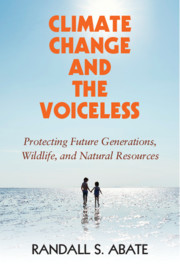Book contents
- Climate Change and the Voiceless
- Climate Change and the Voiceless
- Copyright page
- Dedication
- Contents
- About the Author
- Preface
- Acknowledgments
- 1 An Anthropogenic Problem That Requires an Ecocentric Solution
- 2 Climate Change Litigation in Domestic Courts and Human Rights Commissions
- 3 Protection of Future Generations
- 4 Legal Personhood for Wildlife
- 5 Rights of Nature
- 6 Proposal for Enhanced Stewardship and Rights-Based Protections for the Voiceless
- Subject Index
- Cases Index
4 - Legal Personhood for Wildlife
US and Foreign Domestic Judicial Developments
Published online by Cambridge University Press: 28 October 2019
- Climate Change and the Voiceless
- Climate Change and the Voiceless
- Copyright page
- Dedication
- Contents
- About the Author
- Preface
- Acknowledgments
- 1 An Anthropogenic Problem That Requires an Ecocentric Solution
- 2 Climate Change Litigation in Domestic Courts and Human Rights Commissions
- 3 Protection of Future Generations
- 4 Legal Personhood for Wildlife
- 5 Rights of Nature
- 6 Proposal for Enhanced Stewardship and Rights-Based Protections for the Voiceless
- Subject Index
- Cases Index
Summary
This chapter considers the role of the courts in addressing recent efforts to protect wildlife, the second category of the voiceless. It examines several case studies in the United States and in foreign domestic jurisdictions in which the Nonhuman Rights Project (NhRP) has filed habeas corpus petitions seeking to establish rights for primates and higher mammals to be free from unlawful confinement and abuse. The chapter underscores how persistent and creative efforts to use the common law can be a tool to raise awareness of important changes that need to occur at the constitutional and legislative levels. Animal protection organizations such as NhRP, People for the Ethical Treatment of Animals (PETA), and the Animal Legal Defense Fund (ALDF) have filed cases addressing what qualities wildlife must possess to be entitled to stewardship and guardianship protection in our legal system. If corporations, ships, and natural resources have legal personhood protections, it follows that at least some, if not all, forms of wildlife should enjoy similar protections. Animals are treated as property under US law and in most foreign domestic jurisdictions, and historically have been used as a means to an end to fulfill human needs for food, companionship, and entertainment. This property-based model facilitates exploitation and interferes with the implementation of the legal protections necessary to help ensure ecosystem integrity and protection of wildlife populations in the face of climate change impacts.
- Type
- Chapter
- Information
- Climate Change and the VoicelessProtecting Future Generations, Wildlife, and Natural Resources, pp. 97 - 119Publisher: Cambridge University PressPrint publication year: 2019

